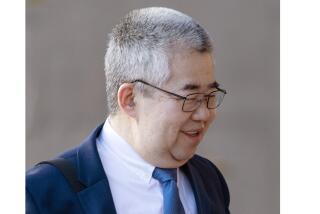McKinzie Jurors, Still Stalemated on Penalty, Ordered to Try Again
- Share via
For a second day, Ventura County Judge Vincent J. O’Neill Jr. told jurors to continue deliberations in Kenneth McKinzie’s death penalty trial--despite a stubborn 11-1 stalemate that panelists say is unlikely to be broken.
“All I am asking you to do is be here Monday,” O’Neill told the clearly frustrated jurors, some of whom shook their heads in disbelief. “I’d like you to come and take at least one more vote.”
The judge’s order came just moments before the jury foreman passed a note raising concerns about statements made by the holdout juror during deliberations.
But concerns about possible misconduct diminished after the lawyers and the judge met with the jury foreman and clarified the issue. The attorneys plan to discuss the matter further Monday morning, however.
For the last three days, the panel of nine women and three men has struggled to reach consensus on whether McKinzie, 39, should be given the death penalty for strangling an elderly Oxnard woman three years ago.
On Thursday, jurors announced they were hung 11 votes to 1 without indicating which way the majority was leaning. At the judge’s urging, the group agreed to wrestle with the issue further.
But by Friday afternoon, nothing had changed. The holdout refused to budge despite what one juror described as a “superhuman” effort to reach consensus.
“There’s no chance,” the foreman grimly announced to the court. “We’ve tried pretty much every angle we could today. It’s not going to change.”
After talking to the foreman individually, O’Neill called the entire jury into his courtroom and questioned the panelists one by one. The responses were the same.
“We’ve worked real hard to reach a unanimous decision,” one female juror said. “This is it.”
But prosecutors were not willing to back down. They urged the judge to send the panel out yet again for further deliberations, a request that prompted a quick and angry reaction from defense attorney Willard Wiksell.
“To make these people come back would be cruel,” Wiksell said.
He accused the prosecution of trying to “break” the holdout juror and told the judge it was clear from the jurors’ comments that they had exhausted every avenue in trying to reach consensus.
But O’Neill said he saw no harm in asking the jury to take a break for the weekend and come back Monday with a fresh perspective.
“All I am asking you to do between now and then,” he told the jurors after calling them back into court, “is think about whether there is any stone left unturned.”
Moments after excusing the panel, O’Neill was handed a note from the jury foreman that raised a question of possible juror misconduct.
The note asked whether it would be grounds for a mistrial if, during the penalty phase, a juror made up his or her mind about what penalty should be imposed before deliberating with the other jurors.
The issue became an immediate concern to the judge and lawyers, who feared that a juror had entered the penalty phase with a predetermined position on the death penalty. That would be grounds for the juror to be dismissed.
For the next hour, the judge questioned the foreman outside the presence of the other jurors, who were sent home until Monday.
The foreman said the holdout juror had revealed two hours into deliberations that he had made up his mind about the appropriate penalty “75%” into the presentation of evidence in the penalty phase of the trial.
“The comment was made, ‘This is a done deal. Let’s go tell the judge and we’re out of here,’ ” the foreman said.
The foreman did not identify the juror or state what position the juror had taken. The foreman did refer to the juror as “he.”
O’Neill asked the juror to step outside the courtroom and discussed the issue with the lawyers. The prosecution asked O’Neill to bounce the holdout juror from the panel and replace him with an alternate.
But Wiksell objected, calling the suggestion a tactic by the prosecution to remove the one juror who may be holding up a unanimous decision to execute his client.
More to Read
Sign up for Essential California
The most important California stories and recommendations in your inbox every morning.
You may occasionally receive promotional content from the Los Angeles Times.













